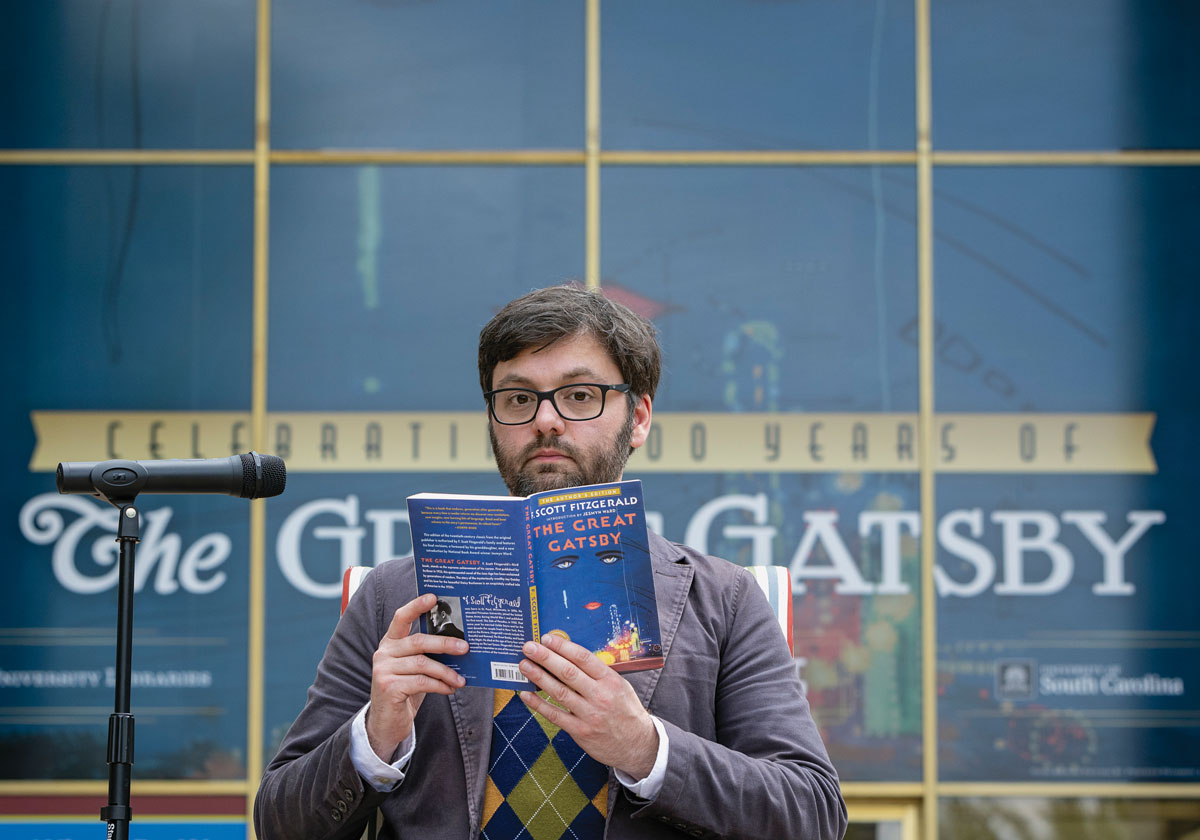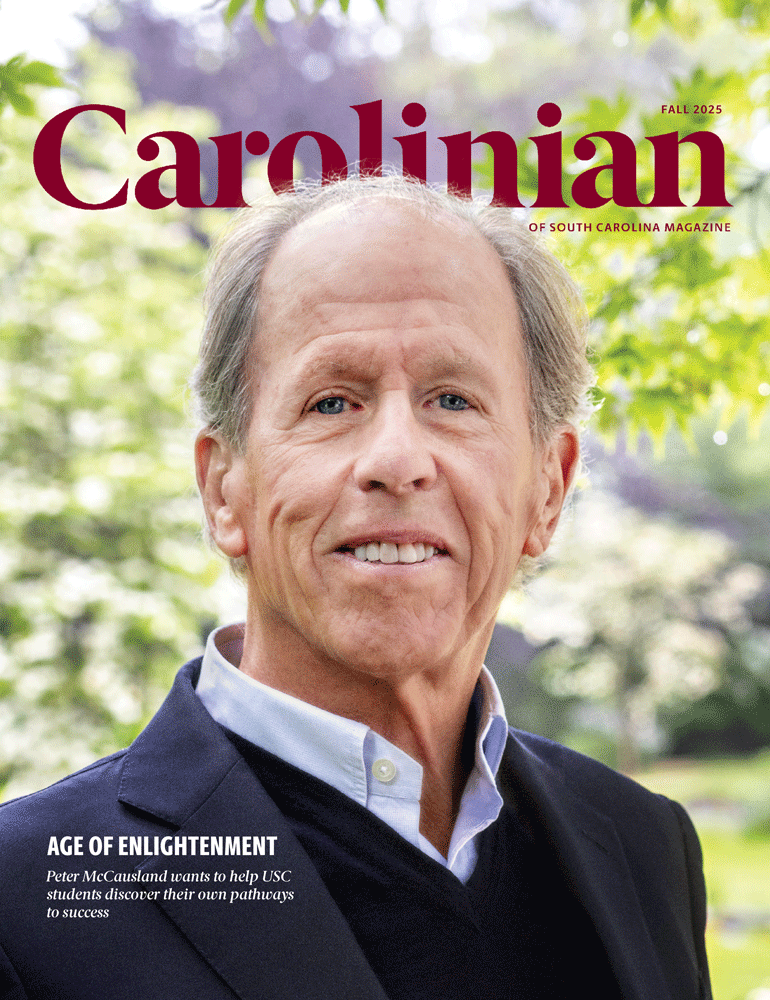Few American novels have captured our imagination like F. Scott Fitzgerald’s The Great Gatsby. The 1925 romantic tragedy is a mainstay of the high school English syllabus and has been adapted multiple times for stage and screen. Fitzgerald’s artful storytelling, meanwhile, has helped shape our image of the era.
Now, University Libraries is bringing the novel to life with a special exhibit marking The Great Gatsby’s 100th anniversary.
“‘Something significant, elemental and profound’: Celebrating 100 Years of The Great Gatsby” is on display at USC’s Hollings Library until July. The exhibit draws primarily from the Matthew J. & Arlyn Bruccoli Collection of F. Scott Fitzgerald, which is housed in USC’s Irvin Department of Rare Books and Special Collections.
“The core of the exhibit is focused on Gatsby because of the 100th anniversary,” says Michael Weisenburg, director of the Irvin Department and the exhibit’s curator. “We’re also doing what we can to round out Fitzgerald as a person, his life and his world, and also the world that he represents in the novel.”
In addition to a first edition of The Great Gatsby and interpretative cases on 1920s culture, exhibit highlights include the corrected galley proofs from Scribner’s, Fitzgerald’s publisher; writer Sylvia Plath’s heavily annotated copy of the novel; Fitzgerald’s ledger, which chronicles the author’s ambitious work schedule and finances; and an engraved silver flask given to Fitzgerald by his wife Zelda when the two were courting.
“What I hope we’ve achieved, with both the exhibition and the events, is a more immersive experience of what it was like to live at this time and what it was like to attend one of Gatsby’s parties.”
But there’s more to the Roaring ’20s than The Great Gatsby, and there’s more to the exhibit than rarities under glass. To round out the dance card, Weisenburg organized a series of free events and enlisted experts from across campus.
“What I hope we’ve achieved, with both the exhibition and the events, is a more immersive experience of what it was like to live at this time and what it was like to attend one of Gatsby’s parties,” says Weisenburg. “We have items on display that give the viewer a more concrete understanding of the world of the novel. These historical artifacts have been supplemented by the experience of listening to music, participating in dance and learning about how the novel relates to modern scholarship of all types.”
Kick up your heels!
When he was planning programming, Weisenburg wanted to kick things off in style — and the campus community stepped up in a Gatsby-sized way.
On Jan. 24, College of Education dance instructor Richard Durlach and his dance partner Breedlove treated the opening night audience to a lively 1920s-themed dance program that started with a history lesson and ended with a conga line.
Durlach, who earned degrees in chemistry and engineering from USC before his hobby became a full-time pursuit, addressed the audience through a vintage megaphone. Breedlove, a retired associate professor of education who earned her Ph.D. from USC in psychological services, provided vintage outfits from her personal wardrobe and served as Durlach’s partner as they demonstrated dances like the waltz.
In between, a select group of USC students from Durlach’s classes and the South Carolina Ballroom Dance Club showed off some of the era’s livelier dances.
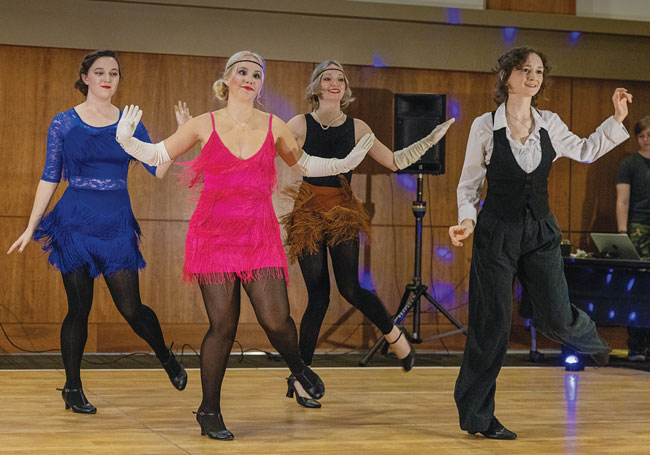
Dancers Whitney Hill, Helena Bernier, Maggie Johnson and Muireall Dickson bring the Charleston to Columbia.
One student dancer was sophomore Muireall Dickson. While Dickson is majoring in environmental science, she has studied dance since her grandmother enrolled her in a ballet class when she was 4 and has taken classes in tap, jazz and contemporary dance. She joined the South Carolina Ballroom Dance Club to learn a few new steps, including the Charleston.
“I knew the basic step just from being involved in the dance community, seeing videos and dancing at social events, but most of the steps that Richard taught us I had never done before,” she says.
She and her fellow dancers also got up to speed on the historical context of the dances they were performing.
“While the wild and crazy young people were out dancing the Charleston and incurring the wrath of their elders, other people were doing elegant ballroom dances like the waltz,” says Durlach. “And then in 1927, which is a transitional period but definitely pertinent to the exhibit, the Lindy Hop sort of stole the show in America.”
Durlach and Breedlove also encouraged audience participation. The owners of Columbia’s historic Big Apple dance hall often use that venue’s namesake dance to get people out of their seats, but since it didn’t come on until 1936, they opted for a conga line instead.
With a little encouragement, the audience got into the spirit. Soon, nearly everyone present, including Weisenburg and Dean of Libraries David Banush, was snaking through the room and kicking up their heels with the student dancers.
“Richard told us, ‘We’re going to just see how people feel and if the vibe is right, we do a conga line,’” says Dickson. “I’d done it before at, like, elementary school dances, but never somewhere with grown adults. But that was Richard’s goal. He wants to make sure that everyone is involved and has fun.”
The Gatsby beat
Whether you’ve read the novel, seen a film adaptation or merely bumped shoulders with Gatsby at a literary cocktail party, you know this much: the Fitzgerald classic is set during the Jazz Age.
But what does that really mean? What did the music of that storied era sound like? Did it swing? Did it cook? How did it shape the culture?
For keyboardist and jazz composition graduate student Christian Moreno Cova, these questions are more than academic. Moreno Cova is part of a seven-piece School of Music jazz combo that performed a set of 1920s-era jazz in the lobby of the Hollings Library on Feb. 4.
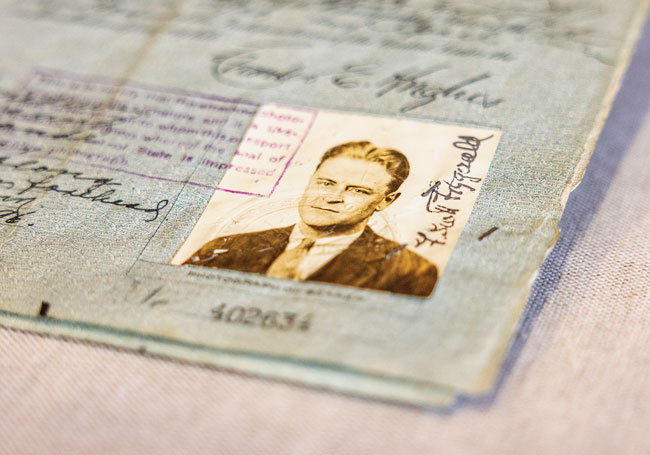
F. Scott Fitzgerald’s passport is just one of the treasures in the Matthew J. & Arlyn Bruccoli Collection.
“Jazz is an idiom that has spanned such a long time,” says Moreno Cova. “But one era that often gets pushed under the table is this earliest era, which is funny because it’s the moment in history when jazz was at its peak as popular music.”
Curated by drummer and assistant professor of jazz studies Colleen Clark, the evening’s playlist leaned heavily on Louis Armstrong but also featured works by Fletcher Henderson, Django Reinhardt and Duke Ellington.
But it wasn’t just guests who got a primer in early jazz, also known as hot jazz. Moreno Cova and his bandmates spent weeks practicing the evening’s selections and immersed themselves in history and theory.
“There’s a lot of stuff that we do in more modern styles of jazz — bebop, post-bop, things that happened later — that really are not appropriate for the time,” the pianist says. “The learning curve comes from having to having to teach yourself not to do some of those things that you might expect and, rather, pick up some of those more idiomatic things that would have been accurate to the music of that era.”
Talk like that is music to Clark’s ears. The professor was also pumped to see the Hollings Library transformed into a jazz venue, with guests tapping their feet and a few cutting the rug.
“I was just proud,” says Clark. “I was like, yep, this is what happens when we do good work, when we show up and we really lean into our good habits. It took a lot of discipline to learn those tunes in a relatively short amount of time because the concert was kind of early in the semester, and none of those cats had any prior experience playing early jazz.”
Extra credit?
One major goal for the Gatsby exhibit was to incorporate voices from as many disciplines on campus as possible. The Lightning Talk Roundtable accomplished exactly that.
In addition to Weisenburg, who discussed the books in Jay Gatsby’s home library and what they tell us about the novel’s titular character, the panel also featured short talks on 1920s architecture, music, food, fashion and business by faculty from several departments.
After Weisenburg invited art history professor Lydia Brandt to talk on architecture in The Great Gatsby, Brandt took her students to the exhibit and realized she needed to revisit the novel, which she hadn’t read since high school.
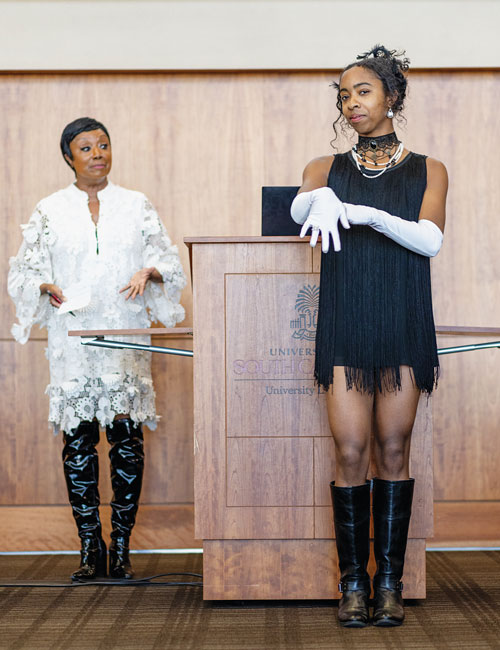
Retailing instructor Stephanie Taylor brought students from her Principles of Fashion of Merchandising class to model clothes from the Gatsby era. Here, senior business major Shania Jackson shows off a classic flapper look.
“I ended up getting much deeper into it than I had planned,” she says. “But I’m very grateful because it was a really rewarding experience.”
It was also enlightening. One of Brandt’s areas of interest is how architecture is employed by Hollywood directors. But while she was familiar with how the domestic architecture of Gatsby’s universe was depicted on screen, she didn’t realize how much of that scene setting is rooted in the novel’s pages.
“I just assumed the directors were making the narrative more visual,” she says. “But when I read the book again, I was like, well, gosh, Fitzgerald is using architecture in really specific and sophisticated ways to communicate some of the book’s main ideas about wealth and class.”
The event was similarly enlightening for Stephanie Taylor, an instructor in the Department of Retailing at USC’s College of Hospitality, Retail and Sport Management. Taylor had four students model period-appropriate outfits from her own closet as she spoke about the fashions of the 1920s and also enjoyed listening to colleagues from other disciplines.
“It was such a quick learning experience,” she says. “When Colleen Clark was talking about jazz, I felt like, ‘Oh my gosh, I would love to take her class.’ And then the talk on architecture was just amazing. I was really inspired by all the panelists.”
The idea to use her students as models didn’t occur to Taylor until a few days before the event, but there was no need for added incentives.
“I told them, ‘I’d love for you to wear some of the silhouettes I’m going to talk about,’” she says. “And I said I’d give them extra credit because I was asking them to do this at the last minute. But then afterwards all of them said, ‘You don’t have to give us extra credit. That was so much fun.’ Isn’t that great? And it really was.”
